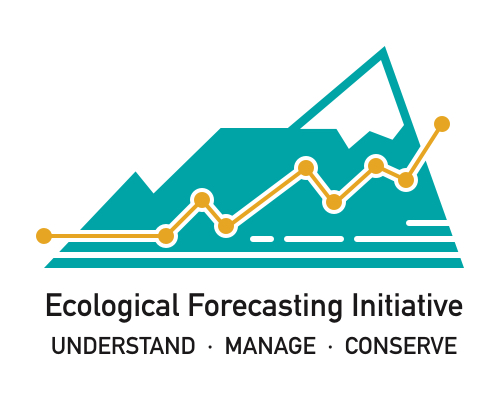site_data <- readr::read_csv("https://raw.githubusercontent.com/eco4cast/neon4cast-targets/main/NEON_Field_Site_Metadata_20220412.csv") |>
dplyr::filter(ticks == 1)3 Theme: Tick Populations
What: Amblyomma americanum nymphal tick abundance per sampled area
Where: 9 NEON sites
When: Forecasts for 4 weeks into the future using a weekly time-step
Why: There is a correlation between tick population abundance and disease incidence, meaning forecasts for tick abundance have the potential to aid in our understanding of disease risk through time and space.
3.1 Overview
Target species for the population forecasts are Amblyomma americanum nymphal ticks. A. americanum is a vector of ehrlichiosis, tularemia, and southern tick-associated rash illness. The species is present in the eastern United States, and their populations are expanding. There is a correlation between tick population abundance and disease incidence, meaning forecasts for tick abundance have the potential to aid in our understanding of disease risk through time and space.
3.2 Challenge
The challenge is open to any individual, group, or institution that may want to participate. The goals of this challenge are to forecast the density of Amblyomma americanum nymphs (ticks/1600m^2) each epidemiological week (Sun-Sat) at nine NEON sites.
3.3 Data: Targets
The challenge uses the following NEON data products:
DP1.10093.001: Ticks sampled using drag cloths
3.3.1 Amblyomma americanum nymphs
Definition
The density of Amblyomma americanum nymphs per week. Density is defined as the total number of individuals caught in a week across the forested plots divided by the total area sampled in the forested plots during the week. Densities are presented as ticks per 1600m^2, as 1600m^2 is the size of an individual NEON tick plot.
Motivation
We chose to use the density of Amblyomma americanum nymphs for several reasons. The first is that Amblyomma americanum is a vector of multiple pathogens, many of which cause human disease, and a forecast for their abundance could aid decisions in public health and personal protective measures. For simplicity, we chose to focus on one species for the abundance challenge, and the Amblyomma americanum nymphs are the most abundant tick observed in the NEON data. Most ticks are observed in to forested plots, and by standardizing the data to density of ticks observed per unit effort in the forested plots, we hope to avoid forecasters predicting sampling effort. We scaled the density to be representative of ticks per plot, which is more interpretable than ticks per square meter. Also, tick drags occur every three weeks. By having the challenge be for forecasting every week, participants won’t have to predict which weeks drags occur.
3.3.2 Focal sites
Information on the sites can be found here:
See Table at end for more information on the sites
3.3.3 Target data calculation
Tick drags occur every three weeks at the NEON sites used in this challenge. The sampling season at each site is determined by phenological milestones, beginning and ending within two weeks of green-up and senescence, respectively. The 1m^2 cloth is dragged for 160m (and at least 80m), and ticks are collected intermittently. They are then sent to a lab for taxonomic identification. Ticks are then identified by life stage and taxonomic rank. The target data is for Amblyomma americanum nymphs that were identified to the species level; i.e. ticks identified as being in the Amblyomma genus are not included.
3.4 Site list table
| siteID | site name | vegetation type | latitude | longtitude | NEON site URL |
|---|---|---|---|---|---|
| BLAN | Blandy Experimental Farm NEON | Deciduous Forest|Pasture/Hay | 39.03370 | -78.04179 | https://www.neonscience.org/field-sites/blan |
| KONZ | Konza Prairie Biological Station NEON | Deciduous Forest|Grassland/Herbaceous | 39.10077 | -96.56307 | https://www.neonscience.org/field-sites/konz |
| LENO | Lenoir Landing NEON | Deciduous Forest|Woody Wetlands | 31.85386 | -88.16118 | https://www.neonscience.org/field-sites/leno |
| ORNL | Oak Ridge NEON | Deciduous Forest|Evergreen Forest|Pasture/Hay | 35.96413 | -84.28259 | https://www.neonscience.org/field-sites/ornl |
| OSBS | Ordway-Swisher Biological Station NEON | Emergent Herbaceous Wetlands|Evergreen Forest|Woody Wetlands | 29.68928 | -81.99343 | https://www.neonscience.org/field-sites/osbs |
| SCBI | Smithsonian Conservation Biology Institute NEON | Deciduous Forest|Evergreen Forest|Pasture/Hay | 38.89292 | -78.13949 | https://www.neonscience.org/field-sites/scbi |
| SERC | Smithsonian Environmental Research Center NEON | Cultivated Crops|Deciduous Forest | 38.89013 | -76.56001 | https://www.neonscience.org/field-sites/serc |
| TALL | Talladega National Forest NEON | Deciduous Forest|Evergreen Forest|Mixed Forest | 32.95047 | -87.39326 | https://www.neonscience.org/field-sites/tall |
| UKFS | University of Kansas Field Station NEON | Deciduous Forest|Pasture/Hay | 39.04043 | -95.19215 | https://www.neonscience.org/field-sites/ukfs |
